Strategic Planning for Tourism and Leisure: A Detailed Analysis
VerifiedAdded on 2020/10/22
|15
|4745
|64
Report
AI Summary
This report delves into the realm of strategic planning within the tourism and leisure sectors. It initiates with an examination of the advantages derived from producing tourism strategic plans, supported by a case study of Disneyland Paris. The report then explores the community-based approach to tourism development, providing an illustrative example of its practical implementation. Further, the report investigates the contribution of historic buildings to strategic tourism development, using a London-based example to showcase the successful integration of heritage sites into the tourism landscape. The report offers a comprehensive analysis of strategic planning methodologies, highlighting the significance of stakeholder involvement and the importance of adapting strategies to cultural contexts, all while emphasizing the need for balanced development that benefits both tourists and local communities.
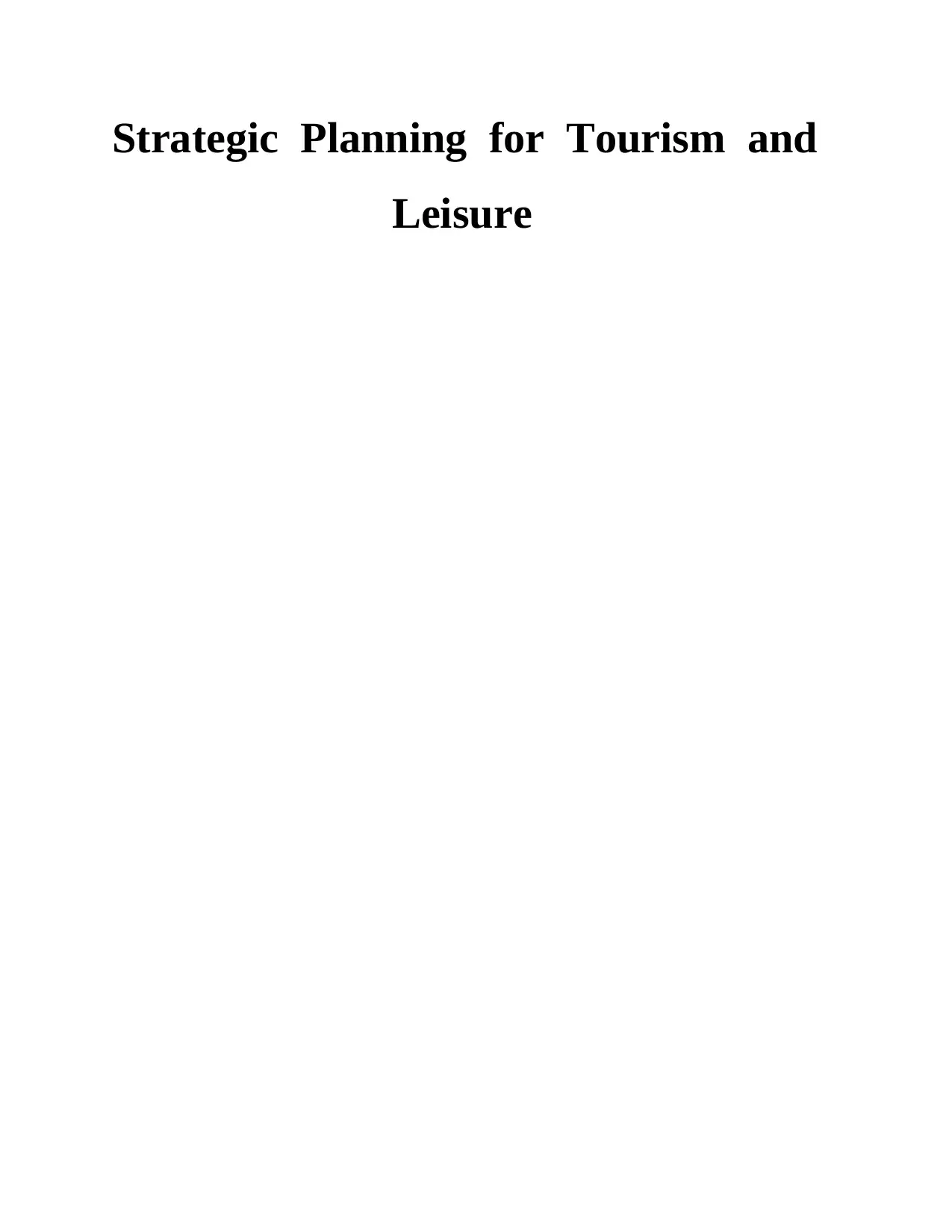
Strategic Planning for Tourism and
Leisure
Leisure
Paraphrase This Document
Need a fresh take? Get an instant paraphrase of this document with our AI Paraphraser
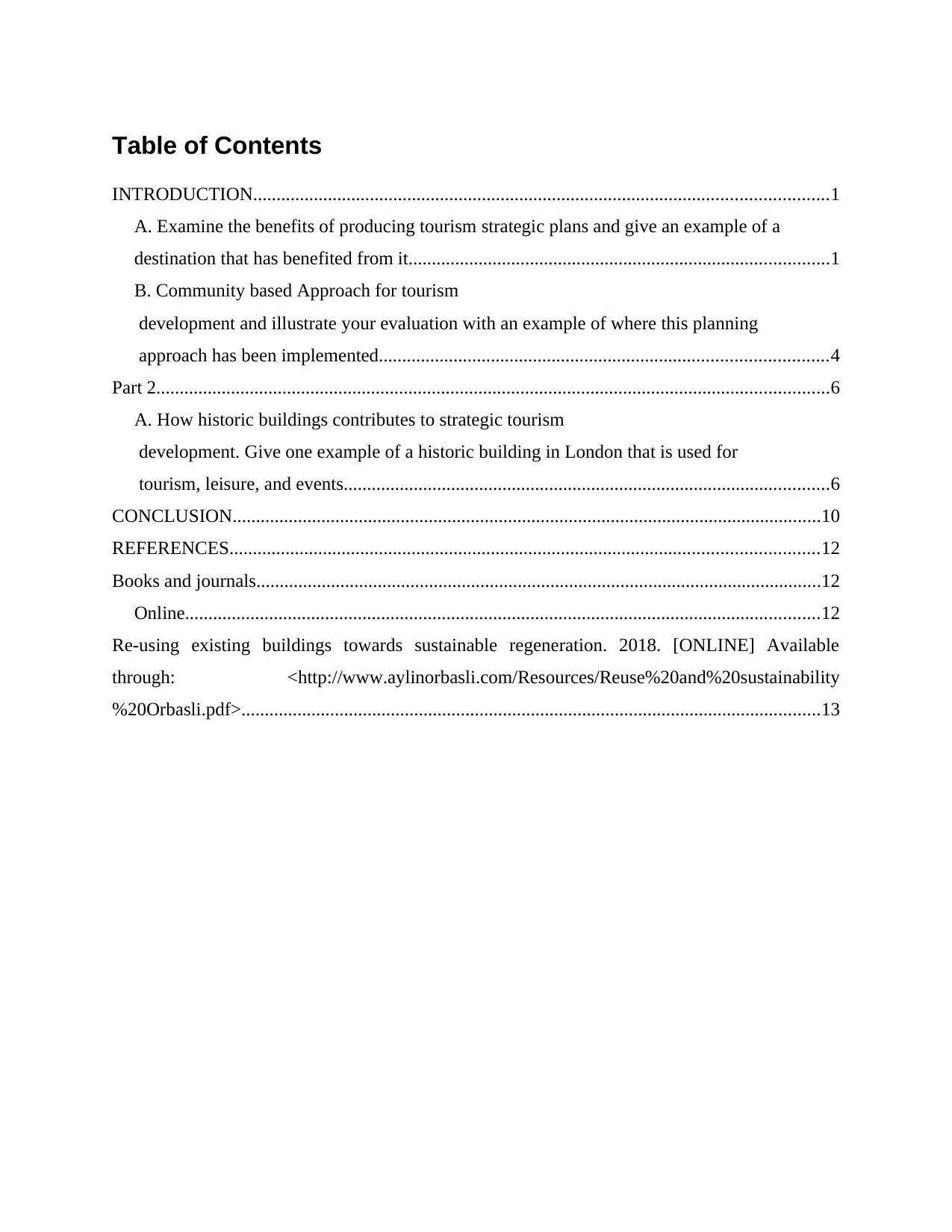
Table of Contents
INTRODUCTION...........................................................................................................................1
A. Examine the benefits of producing tourism strategic plans and give an example of a
destination that has benefited from it..........................................................................................1
B. Community based Approach for tourism
development and illustrate your evaluation with an example of where this planning
approach has been implemented................................................................................................4
Part 2................................................................................................................................................6
A. How historic buildings contributes to strategic tourism
development. Give one example of a historic building in London that is used for
tourism, leisure, and events........................................................................................................6
CONCLUSION..............................................................................................................................10
REFERENCES..............................................................................................................................12
Books and journals.........................................................................................................................12
Online........................................................................................................................................12
Re-using existing buildings towards sustainable regeneration. 2018. [ONLINE] Available
through: <http://www.aylinorbasli.com/Resources/Reuse%20and%20sustainability
%20Orbasli.pdf>............................................................................................................................13
INTRODUCTION...........................................................................................................................1
A. Examine the benefits of producing tourism strategic plans and give an example of a
destination that has benefited from it..........................................................................................1
B. Community based Approach for tourism
development and illustrate your evaluation with an example of where this planning
approach has been implemented................................................................................................4
Part 2................................................................................................................................................6
A. How historic buildings contributes to strategic tourism
development. Give one example of a historic building in London that is used for
tourism, leisure, and events........................................................................................................6
CONCLUSION..............................................................................................................................10
REFERENCES..............................................................................................................................12
Books and journals.........................................................................................................................12
Online........................................................................................................................................12
Re-using existing buildings towards sustainable regeneration. 2018. [ONLINE] Available
through: <http://www.aylinorbasli.com/Resources/Reuse%20and%20sustainability
%20Orbasli.pdf>............................................................................................................................13
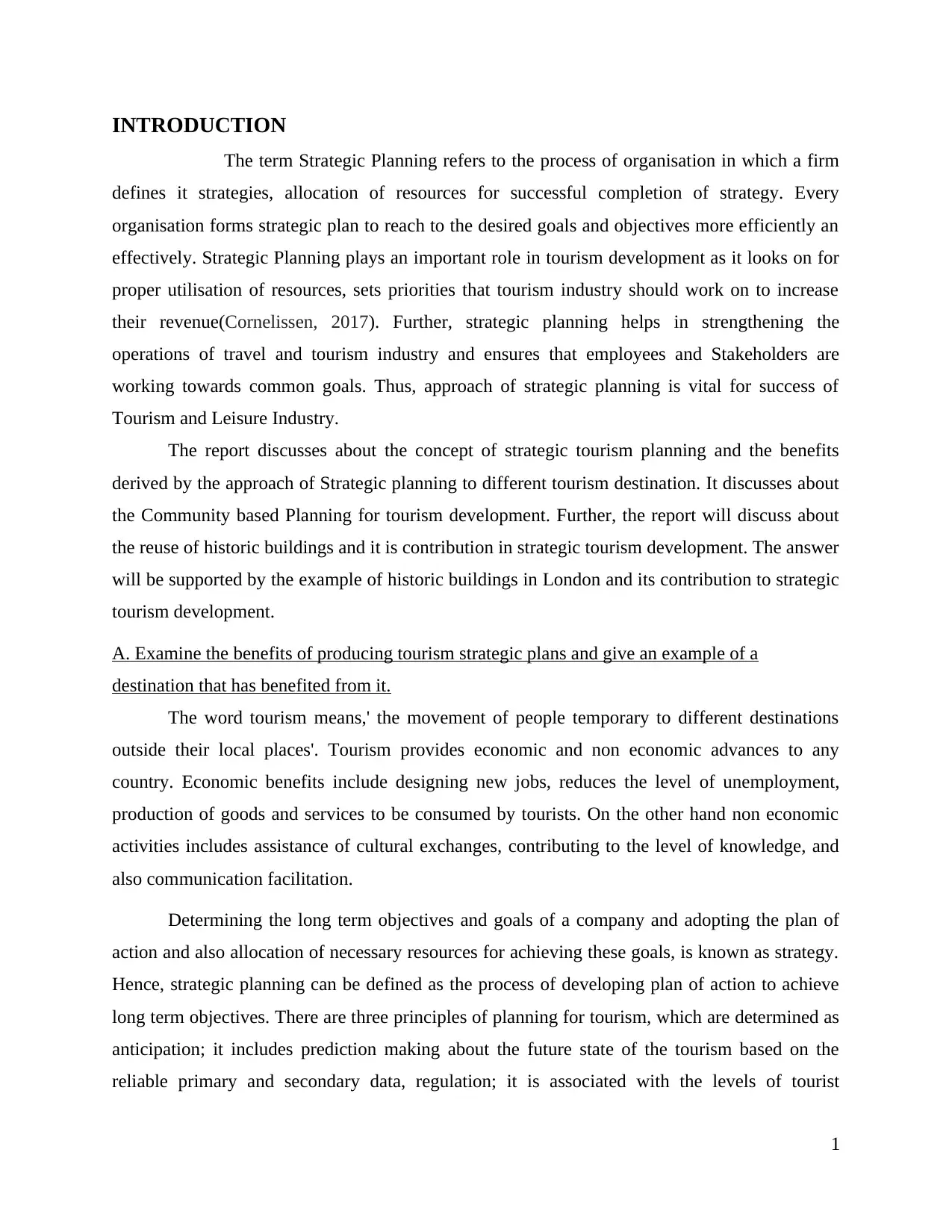
INTRODUCTION
The term Strategic Planning refers to the process of organisation in which a firm
defines it strategies, allocation of resources for successful completion of strategy. Every
organisation forms strategic plan to reach to the desired goals and objectives more efficiently an
effectively. Strategic Planning plays an important role in tourism development as it looks on for
proper utilisation of resources, sets priorities that tourism industry should work on to increase
their revenue(Cornelissen, 2017). Further, strategic planning helps in strengthening the
operations of travel and tourism industry and ensures that employees and Stakeholders are
working towards common goals. Thus, approach of strategic planning is vital for success of
Tourism and Leisure Industry.
The report discusses about the concept of strategic tourism planning and the benefits
derived by the approach of Strategic planning to different tourism destination. It discusses about
the Community based Planning for tourism development. Further, the report will discuss about
the reuse of historic buildings and it is contribution in strategic tourism development. The answer
will be supported by the example of historic buildings in London and its contribution to strategic
tourism development.
A. Examine the benefits of producing tourism strategic plans and give an example of a
destination that has benefited from it.
The word tourism means,' the movement of people temporary to different destinations
outside their local places'. Tourism provides economic and non economic advances to any
country. Economic benefits include designing new jobs, reduces the level of unemployment,
production of goods and services to be consumed by tourists. On the other hand non economic
activities includes assistance of cultural exchanges, contributing to the level of knowledge, and
also communication facilitation.
Determining the long term objectives and goals of a company and adopting the plan of
action and also allocation of necessary resources for achieving these goals, is known as strategy.
Hence, strategic planning can be defined as the process of developing plan of action to achieve
long term objectives. There are three principles of planning for tourism, which are determined as
anticipation; it includes prediction making about the future state of the tourism based on the
reliable primary and secondary data, regulation; it is associated with the levels of tourist
1
The term Strategic Planning refers to the process of organisation in which a firm
defines it strategies, allocation of resources for successful completion of strategy. Every
organisation forms strategic plan to reach to the desired goals and objectives more efficiently an
effectively. Strategic Planning plays an important role in tourism development as it looks on for
proper utilisation of resources, sets priorities that tourism industry should work on to increase
their revenue(Cornelissen, 2017). Further, strategic planning helps in strengthening the
operations of travel and tourism industry and ensures that employees and Stakeholders are
working towards common goals. Thus, approach of strategic planning is vital for success of
Tourism and Leisure Industry.
The report discusses about the concept of strategic tourism planning and the benefits
derived by the approach of Strategic planning to different tourism destination. It discusses about
the Community based Planning for tourism development. Further, the report will discuss about
the reuse of historic buildings and it is contribution in strategic tourism development. The answer
will be supported by the example of historic buildings in London and its contribution to strategic
tourism development.
A. Examine the benefits of producing tourism strategic plans and give an example of a
destination that has benefited from it.
The word tourism means,' the movement of people temporary to different destinations
outside their local places'. Tourism provides economic and non economic advances to any
country. Economic benefits include designing new jobs, reduces the level of unemployment,
production of goods and services to be consumed by tourists. On the other hand non economic
activities includes assistance of cultural exchanges, contributing to the level of knowledge, and
also communication facilitation.
Determining the long term objectives and goals of a company and adopting the plan of
action and also allocation of necessary resources for achieving these goals, is known as strategy.
Hence, strategic planning can be defined as the process of developing plan of action to achieve
long term objectives. There are three principles of planning for tourism, which are determined as
anticipation; it includes prediction making about the future state of the tourism based on the
reliable primary and secondary data, regulation; it is associated with the levels of tourist
1
⊘ This is a preview!⊘
Do you want full access?
Subscribe today to unlock all pages.

Trusted by 1+ million students worldwide
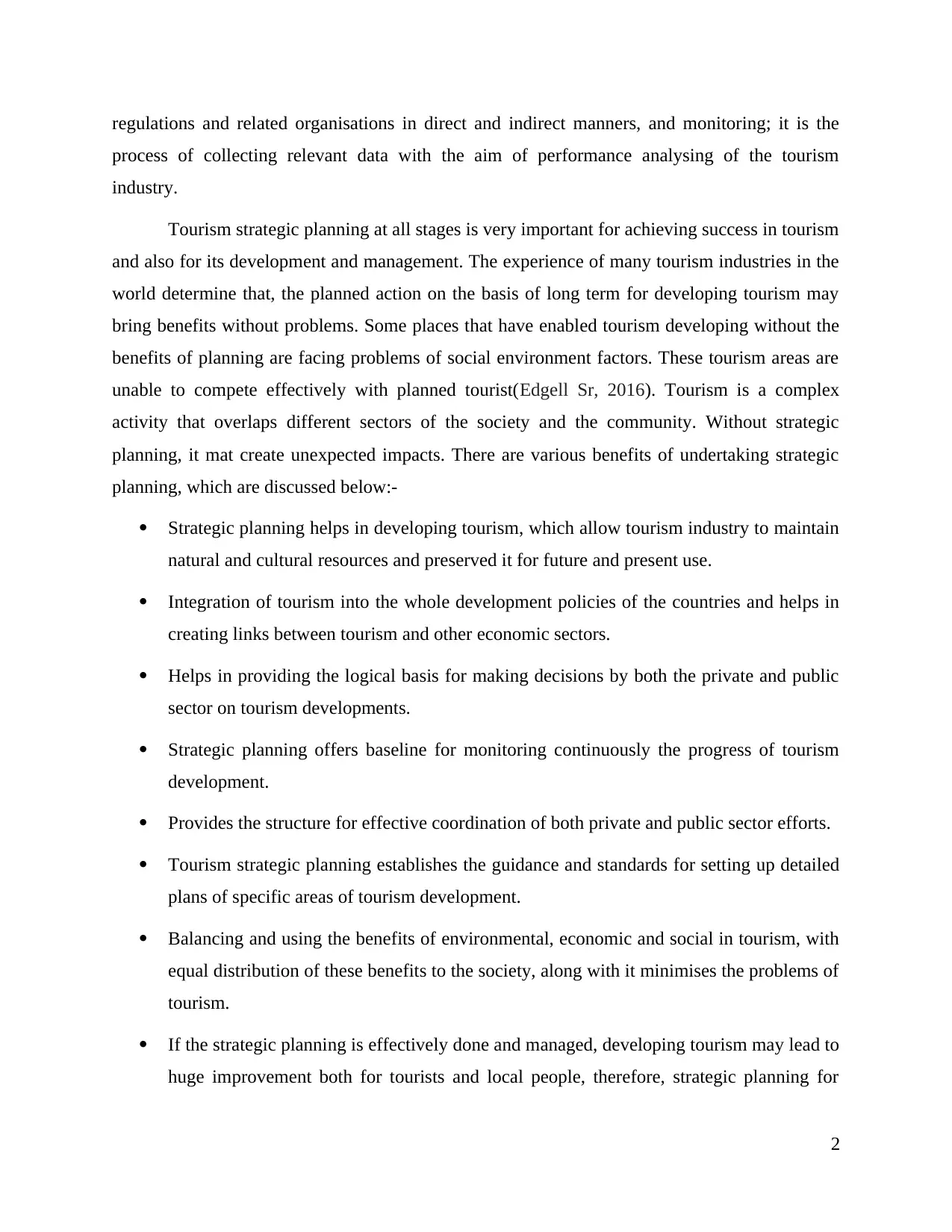
regulations and related organisations in direct and indirect manners, and monitoring; it is the
process of collecting relevant data with the aim of performance analysing of the tourism
industry.
Tourism strategic planning at all stages is very important for achieving success in tourism
and also for its development and management. The experience of many tourism industries in the
world determine that, the planned action on the basis of long term for developing tourism may
bring benefits without problems. Some places that have enabled tourism developing without the
benefits of planning are facing problems of social environment factors. These tourism areas are
unable to compete effectively with planned tourist(Edgell Sr, 2016). Tourism is a complex
activity that overlaps different sectors of the society and the community. Without strategic
planning, it mat create unexpected impacts. There are various benefits of undertaking strategic
planning, which are discussed below:-
Strategic planning helps in developing tourism, which allow tourism industry to maintain
natural and cultural resources and preserved it for future and present use.
Integration of tourism into the whole development policies of the countries and helps in
creating links between tourism and other economic sectors.
Helps in providing the logical basis for making decisions by both the private and public
sector on tourism developments.
Strategic planning offers baseline for monitoring continuously the progress of tourism
development.
Provides the structure for effective coordination of both private and public sector efforts.
Tourism strategic planning establishes the guidance and standards for setting up detailed
plans of specific areas of tourism development.
Balancing and using the benefits of environmental, economic and social in tourism, with
equal distribution of these benefits to the society, along with it minimises the problems of
tourism.
If the strategic planning is effectively done and managed, developing tourism may lead to
huge improvement both for tourists and local people, therefore, strategic planning for
2
process of collecting relevant data with the aim of performance analysing of the tourism
industry.
Tourism strategic planning at all stages is very important for achieving success in tourism
and also for its development and management. The experience of many tourism industries in the
world determine that, the planned action on the basis of long term for developing tourism may
bring benefits without problems. Some places that have enabled tourism developing without the
benefits of planning are facing problems of social environment factors. These tourism areas are
unable to compete effectively with planned tourist(Edgell Sr, 2016). Tourism is a complex
activity that overlaps different sectors of the society and the community. Without strategic
planning, it mat create unexpected impacts. There are various benefits of undertaking strategic
planning, which are discussed below:-
Strategic planning helps in developing tourism, which allow tourism industry to maintain
natural and cultural resources and preserved it for future and present use.
Integration of tourism into the whole development policies of the countries and helps in
creating links between tourism and other economic sectors.
Helps in providing the logical basis for making decisions by both the private and public
sector on tourism developments.
Strategic planning offers baseline for monitoring continuously the progress of tourism
development.
Provides the structure for effective coordination of both private and public sector efforts.
Tourism strategic planning establishes the guidance and standards for setting up detailed
plans of specific areas of tourism development.
Balancing and using the benefits of environmental, economic and social in tourism, with
equal distribution of these benefits to the society, along with it minimises the problems of
tourism.
If the strategic planning is effectively done and managed, developing tourism may lead to
huge improvement both for tourists and local people, therefore, strategic planning for
2
Paraphrase This Document
Need a fresh take? Get an instant paraphrase of this document with our AI Paraphraser
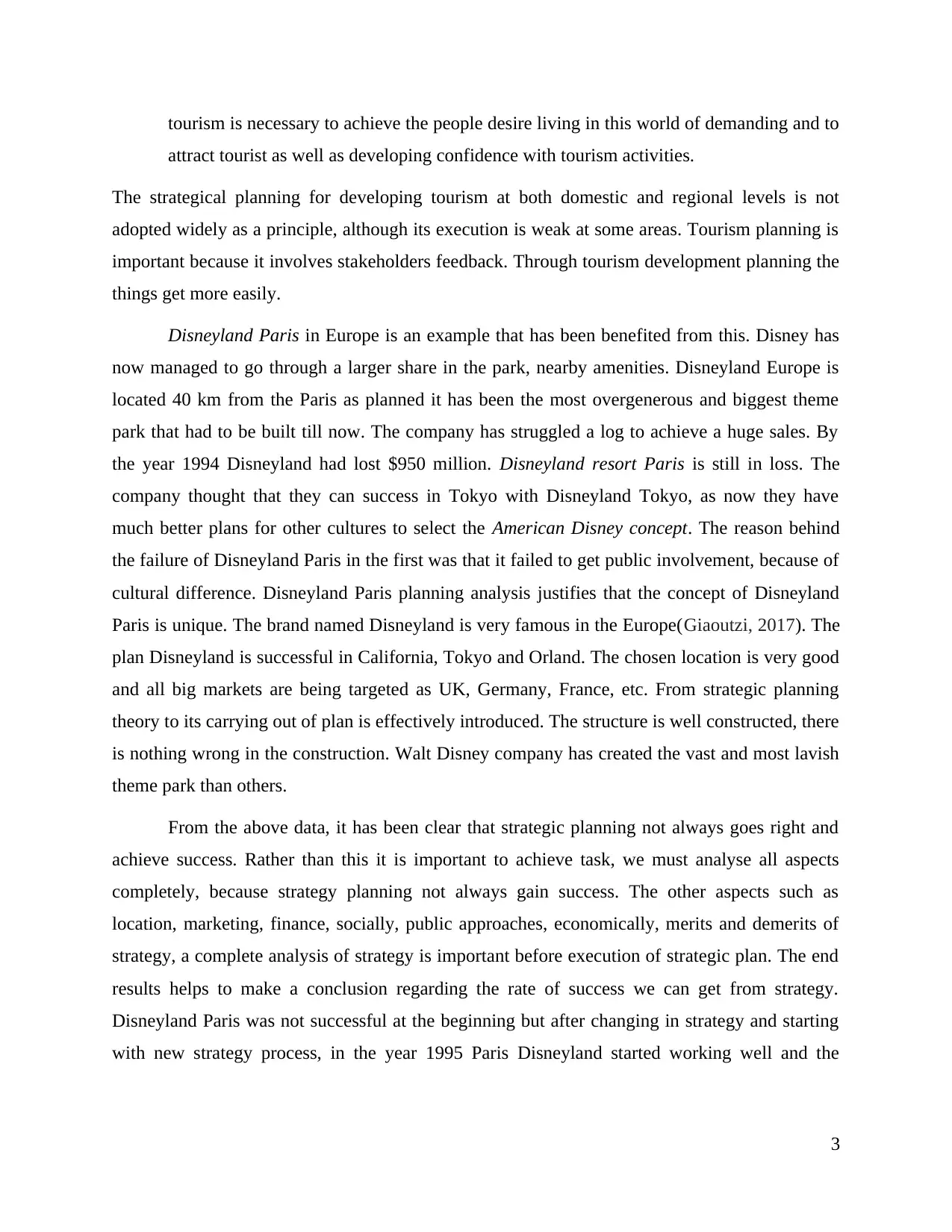
tourism is necessary to achieve the people desire living in this world of demanding and to
attract tourist as well as developing confidence with tourism activities.
The strategical planning for developing tourism at both domestic and regional levels is not
adopted widely as a principle, although its execution is weak at some areas. Tourism planning is
important because it involves stakeholders feedback. Through tourism development planning the
things get more easily.
Disneyland Paris in Europe is an example that has been benefited from this. Disney has
now managed to go through a larger share in the park, nearby amenities. Disneyland Europe is
located 40 km from the Paris as planned it has been the most overgenerous and biggest theme
park that had to be built till now. The company has struggled a log to achieve a huge sales. By
the year 1994 Disneyland had lost $950 million. Disneyland resort Paris is still in loss. The
company thought that they can success in Tokyo with Disneyland Tokyo, as now they have
much better plans for other cultures to select the American Disney concept. The reason behind
the failure of Disneyland Paris in the first was that it failed to get public involvement, because of
cultural difference. Disneyland Paris planning analysis justifies that the concept of Disneyland
Paris is unique. The brand named Disneyland is very famous in the Europe(Giaoutzi, 2017). The
plan Disneyland is successful in California, Tokyo and Orland. The chosen location is very good
and all big markets are being targeted as UK, Germany, France, etc. From strategic planning
theory to its carrying out of plan is effectively introduced. The structure is well constructed, there
is nothing wrong in the construction. Walt Disney company has created the vast and most lavish
theme park than others.
From the above data, it has been clear that strategic planning not always goes right and
achieve success. Rather than this it is important to achieve task, we must analyse all aspects
completely, because strategy planning not always gain success. The other aspects such as
location, marketing, finance, socially, public approaches, economically, merits and demerits of
strategy, a complete analysis of strategy is important before execution of strategic plan. The end
results helps to make a conclusion regarding the rate of success we can get from strategy.
Disneyland Paris was not successful at the beginning but after changing in strategy and starting
with new strategy process, in the year 1995 Paris Disneyland started working well and the
3
attract tourist as well as developing confidence with tourism activities.
The strategical planning for developing tourism at both domestic and regional levels is not
adopted widely as a principle, although its execution is weak at some areas. Tourism planning is
important because it involves stakeholders feedback. Through tourism development planning the
things get more easily.
Disneyland Paris in Europe is an example that has been benefited from this. Disney has
now managed to go through a larger share in the park, nearby amenities. Disneyland Europe is
located 40 km from the Paris as planned it has been the most overgenerous and biggest theme
park that had to be built till now. The company has struggled a log to achieve a huge sales. By
the year 1994 Disneyland had lost $950 million. Disneyland resort Paris is still in loss. The
company thought that they can success in Tokyo with Disneyland Tokyo, as now they have
much better plans for other cultures to select the American Disney concept. The reason behind
the failure of Disneyland Paris in the first was that it failed to get public involvement, because of
cultural difference. Disneyland Paris planning analysis justifies that the concept of Disneyland
Paris is unique. The brand named Disneyland is very famous in the Europe(Giaoutzi, 2017). The
plan Disneyland is successful in California, Tokyo and Orland. The chosen location is very good
and all big markets are being targeted as UK, Germany, France, etc. From strategic planning
theory to its carrying out of plan is effectively introduced. The structure is well constructed, there
is nothing wrong in the construction. Walt Disney company has created the vast and most lavish
theme park than others.
From the above data, it has been clear that strategic planning not always goes right and
achieve success. Rather than this it is important to achieve task, we must analyse all aspects
completely, because strategy planning not always gain success. The other aspects such as
location, marketing, finance, socially, public approaches, economically, merits and demerits of
strategy, a complete analysis of strategy is important before execution of strategic plan. The end
results helps to make a conclusion regarding the rate of success we can get from strategy.
Disneyland Paris was not successful at the beginning but after changing in strategy and starting
with new strategy process, in the year 1995 Paris Disneyland started working well and the
3
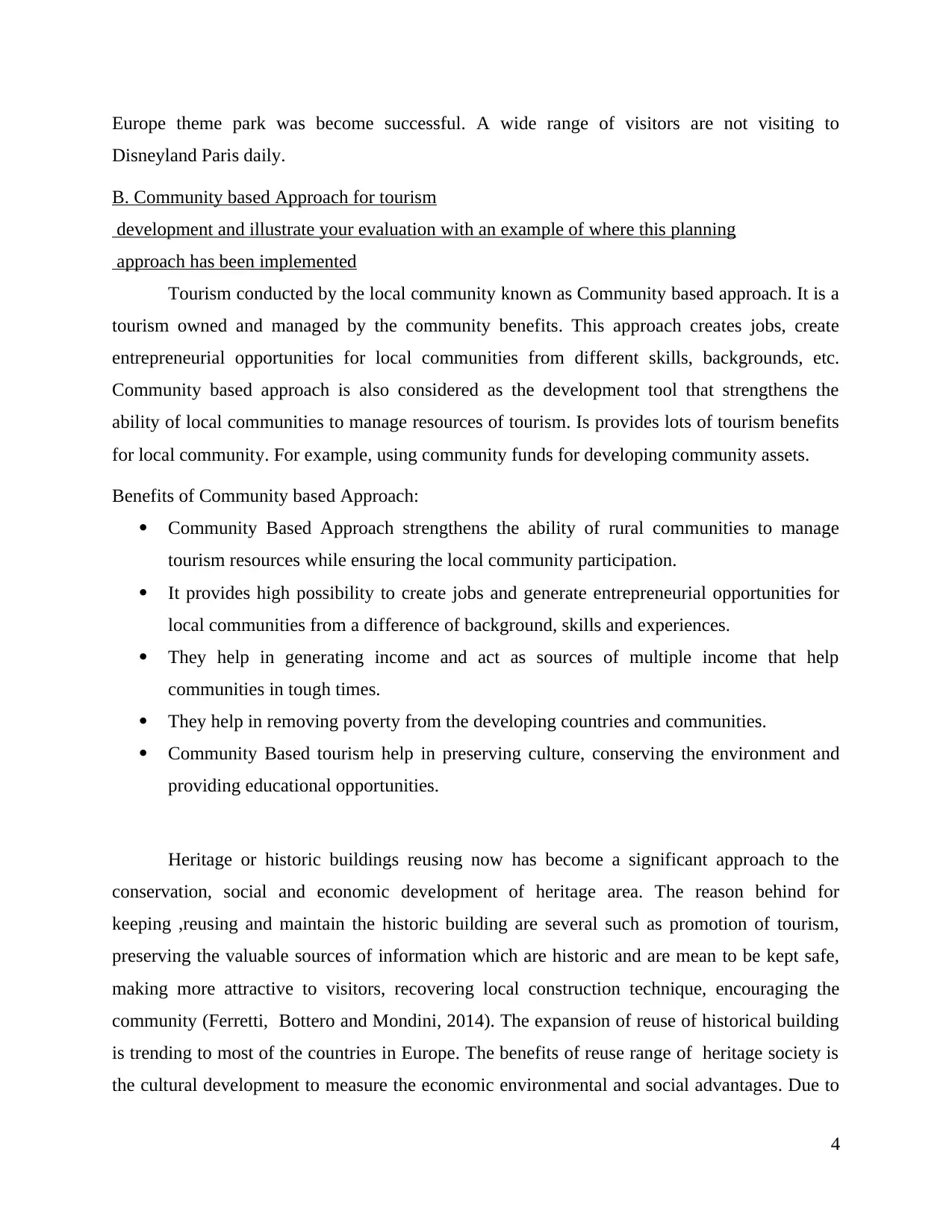
Europe theme park was become successful. A wide range of visitors are not visiting to
Disneyland Paris daily.
B. Community based Approach for tourism
development and illustrate your evaluation with an example of where this planning
approach has been implemented
Tourism conducted by the local community known as Community based approach. It is a
tourism owned and managed by the community benefits. This approach creates jobs, create
entrepreneurial opportunities for local communities from different skills, backgrounds, etc.
Community based approach is also considered as the development tool that strengthens the
ability of local communities to manage resources of tourism. Is provides lots of tourism benefits
for local community. For example, using community funds for developing community assets.
Benefits of Community based Approach:
Community Based Approach strengthens the ability of rural communities to manage
tourism resources while ensuring the local community participation.
It provides high possibility to create jobs and generate entrepreneurial opportunities for
local communities from a difference of background, skills and experiences.
They help in generating income and act as sources of multiple income that help
communities in tough times.
They help in removing poverty from the developing countries and communities.
Community Based tourism help in preserving culture, conserving the environment and
providing educational opportunities.
Heritage or historic buildings reusing now has become a significant approach to the
conservation, social and economic development of heritage area. The reason behind for
keeping ,reusing and maintain the historic building are several such as promotion of tourism,
preserving the valuable sources of information which are historic and are mean to be kept safe,
making more attractive to visitors, recovering local construction technique, encouraging the
community (Ferretti, Bottero and Mondini, 2014). The expansion of reuse of historical building
is trending to most of the countries in Europe. The benefits of reuse range of heritage society is
the cultural development to measure the economic environmental and social advantages. Due to
4
Disneyland Paris daily.
B. Community based Approach for tourism
development and illustrate your evaluation with an example of where this planning
approach has been implemented
Tourism conducted by the local community known as Community based approach. It is a
tourism owned and managed by the community benefits. This approach creates jobs, create
entrepreneurial opportunities for local communities from different skills, backgrounds, etc.
Community based approach is also considered as the development tool that strengthens the
ability of local communities to manage resources of tourism. Is provides lots of tourism benefits
for local community. For example, using community funds for developing community assets.
Benefits of Community based Approach:
Community Based Approach strengthens the ability of rural communities to manage
tourism resources while ensuring the local community participation.
It provides high possibility to create jobs and generate entrepreneurial opportunities for
local communities from a difference of background, skills and experiences.
They help in generating income and act as sources of multiple income that help
communities in tough times.
They help in removing poverty from the developing countries and communities.
Community Based tourism help in preserving culture, conserving the environment and
providing educational opportunities.
Heritage or historic buildings reusing now has become a significant approach to the
conservation, social and economic development of heritage area. The reason behind for
keeping ,reusing and maintain the historic building are several such as promotion of tourism,
preserving the valuable sources of information which are historic and are mean to be kept safe,
making more attractive to visitors, recovering local construction technique, encouraging the
community (Ferretti, Bottero and Mondini, 2014). The expansion of reuse of historical building
is trending to most of the countries in Europe. The benefits of reuse range of heritage society is
the cultural development to measure the economic environmental and social advantages. Due to
4
⊘ This is a preview!⊘
Do you want full access?
Subscribe today to unlock all pages.

Trusted by 1+ million students worldwide
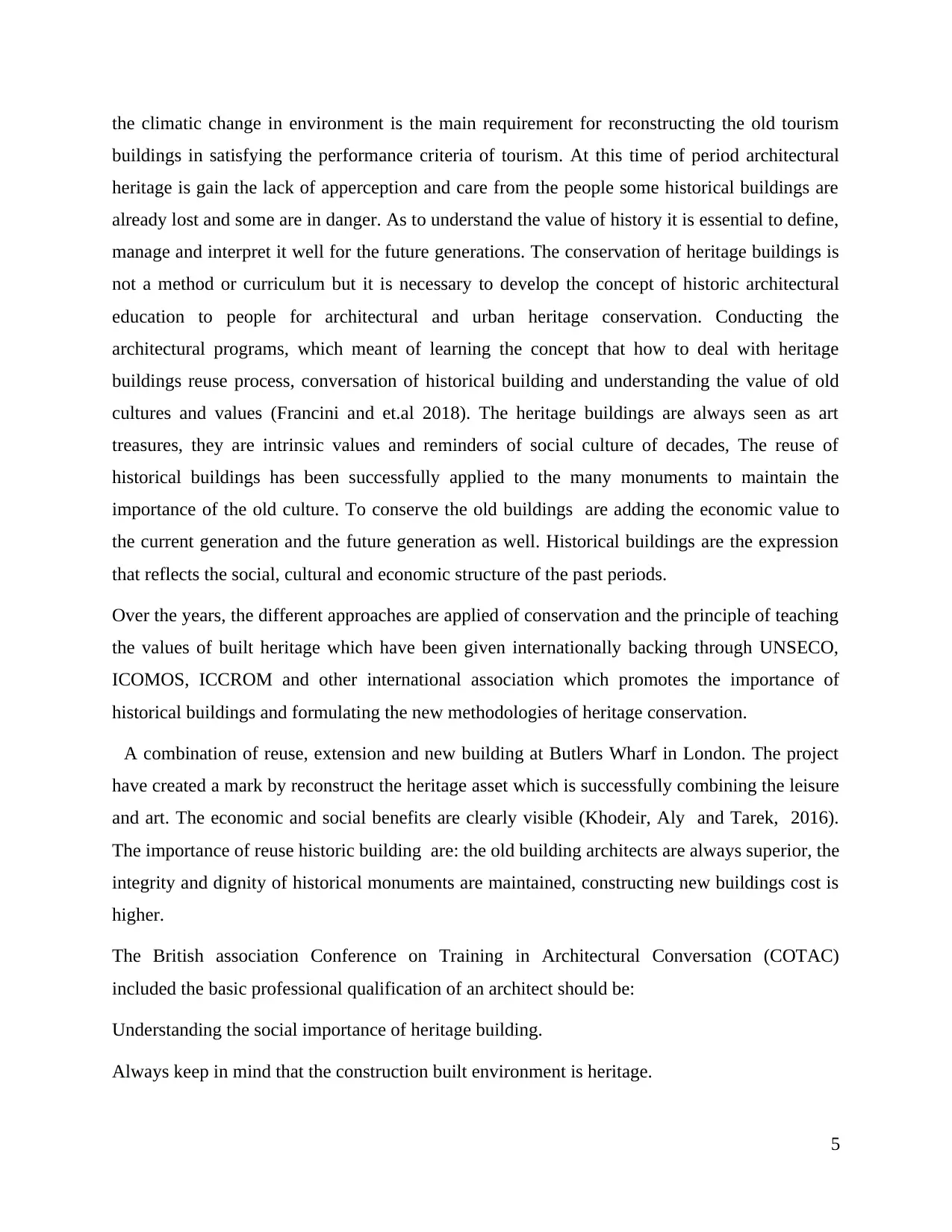
the climatic change in environment is the main requirement for reconstructing the old tourism
buildings in satisfying the performance criteria of tourism. At this time of period architectural
heritage is gain the lack of apperception and care from the people some historical buildings are
already lost and some are in danger. As to understand the value of history it is essential to define,
manage and interpret it well for the future generations. The conservation of heritage buildings is
not a method or curriculum but it is necessary to develop the concept of historic architectural
education to people for architectural and urban heritage conservation. Conducting the
architectural programs, which meant of learning the concept that how to deal with heritage
buildings reuse process, conversation of historical building and understanding the value of old
cultures and values (Francini and et.al 2018). The heritage buildings are always seen as art
treasures, they are intrinsic values and reminders of social culture of decades, The reuse of
historical buildings has been successfully applied to the many monuments to maintain the
importance of the old culture. To conserve the old buildings are adding the economic value to
the current generation and the future generation as well. Historical buildings are the expression
that reflects the social, cultural and economic structure of the past periods.
Over the years, the different approaches are applied of conservation and the principle of teaching
the values of built heritage which have been given internationally backing through UNSECO,
ICOMOS, ICCROM and other international association which promotes the importance of
historical buildings and formulating the new methodologies of heritage conservation.
A combination of reuse, extension and new building at Butlers Wharf in London. The project
have created a mark by reconstruct the heritage asset which is successfully combining the leisure
and art. The economic and social benefits are clearly visible (Khodeir, Aly and Tarek, 2016).
The importance of reuse historic building are: the old building architects are always superior, the
integrity and dignity of historical monuments are maintained, constructing new buildings cost is
higher.
The British association Conference on Training in Architectural Conversation (COTAC)
included the basic professional qualification of an architect should be:
Understanding the social importance of heritage building.
Always keep in mind that the construction built environment is heritage.
5
buildings in satisfying the performance criteria of tourism. At this time of period architectural
heritage is gain the lack of apperception and care from the people some historical buildings are
already lost and some are in danger. As to understand the value of history it is essential to define,
manage and interpret it well for the future generations. The conservation of heritage buildings is
not a method or curriculum but it is necessary to develop the concept of historic architectural
education to people for architectural and urban heritage conservation. Conducting the
architectural programs, which meant of learning the concept that how to deal with heritage
buildings reuse process, conversation of historical building and understanding the value of old
cultures and values (Francini and et.al 2018). The heritage buildings are always seen as art
treasures, they are intrinsic values and reminders of social culture of decades, The reuse of
historical buildings has been successfully applied to the many monuments to maintain the
importance of the old culture. To conserve the old buildings are adding the economic value to
the current generation and the future generation as well. Historical buildings are the expression
that reflects the social, cultural and economic structure of the past periods.
Over the years, the different approaches are applied of conservation and the principle of teaching
the values of built heritage which have been given internationally backing through UNSECO,
ICOMOS, ICCROM and other international association which promotes the importance of
historical buildings and formulating the new methodologies of heritage conservation.
A combination of reuse, extension and new building at Butlers Wharf in London. The project
have created a mark by reconstruct the heritage asset which is successfully combining the leisure
and art. The economic and social benefits are clearly visible (Khodeir, Aly and Tarek, 2016).
The importance of reuse historic building are: the old building architects are always superior, the
integrity and dignity of historical monuments are maintained, constructing new buildings cost is
higher.
The British association Conference on Training in Architectural Conversation (COTAC)
included the basic professional qualification of an architect should be:
Understanding the social importance of heritage building.
Always keep in mind that the construction built environment is heritage.
5
Paraphrase This Document
Need a fresh take? Get an instant paraphrase of this document with our AI Paraphraser
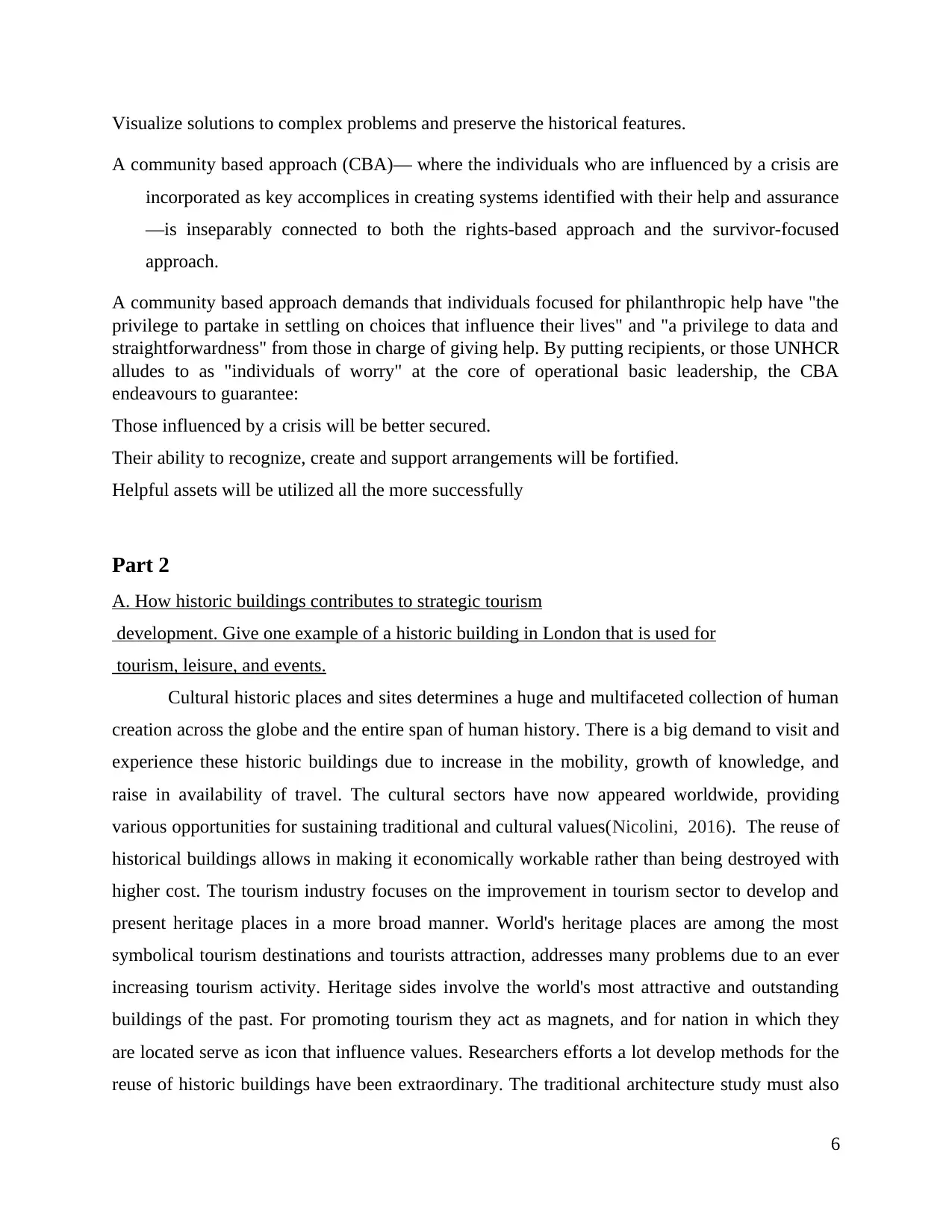
Visualize solutions to complex problems and preserve the historical features.
A community based approach (CBA)— where the individuals who are influenced by a crisis are
incorporated as key accomplices in creating systems identified with their help and assurance
—is inseparably connected to both the rights-based approach and the survivor-focused
approach.
A community based approach demands that individuals focused for philanthropic help have "the
privilege to partake in settling on choices that influence their lives" and "a privilege to data and
straightforwardness" from those in charge of giving help. By putting recipients, or those UNHCR
alludes to as "individuals of worry" at the core of operational basic leadership, the CBA
endeavours to guarantee:
Those influenced by a crisis will be better secured.
Their ability to recognize, create and support arrangements will be fortified.
Helpful assets will be utilized all the more successfully
Part 2
A. How historic buildings contributes to strategic tourism
development. Give one example of a historic building in London that is used for
tourism, leisure, and events.
Cultural historic places and sites determines a huge and multifaceted collection of human
creation across the globe and the entire span of human history. There is a big demand to visit and
experience these historic buildings due to increase in the mobility, growth of knowledge, and
raise in availability of travel. The cultural sectors have now appeared worldwide, providing
various opportunities for sustaining traditional and cultural values(Nicolini, 2016). The reuse of
historical buildings allows in making it economically workable rather than being destroyed with
higher cost. The tourism industry focuses on the improvement in tourism sector to develop and
present heritage places in a more broad manner. World's heritage places are among the most
symbolical tourism destinations and tourists attraction, addresses many problems due to an ever
increasing tourism activity. Heritage sides involve the world's most attractive and outstanding
buildings of the past. For promoting tourism they act as magnets, and for nation in which they
are located serve as icon that influence values. Researchers efforts a lot develop methods for the
reuse of historic buildings have been extraordinary. The traditional architecture study must also
6
A community based approach (CBA)— where the individuals who are influenced by a crisis are
incorporated as key accomplices in creating systems identified with their help and assurance
—is inseparably connected to both the rights-based approach and the survivor-focused
approach.
A community based approach demands that individuals focused for philanthropic help have "the
privilege to partake in settling on choices that influence their lives" and "a privilege to data and
straightforwardness" from those in charge of giving help. By putting recipients, or those UNHCR
alludes to as "individuals of worry" at the core of operational basic leadership, the CBA
endeavours to guarantee:
Those influenced by a crisis will be better secured.
Their ability to recognize, create and support arrangements will be fortified.
Helpful assets will be utilized all the more successfully
Part 2
A. How historic buildings contributes to strategic tourism
development. Give one example of a historic building in London that is used for
tourism, leisure, and events.
Cultural historic places and sites determines a huge and multifaceted collection of human
creation across the globe and the entire span of human history. There is a big demand to visit and
experience these historic buildings due to increase in the mobility, growth of knowledge, and
raise in availability of travel. The cultural sectors have now appeared worldwide, providing
various opportunities for sustaining traditional and cultural values(Nicolini, 2016). The reuse of
historical buildings allows in making it economically workable rather than being destroyed with
higher cost. The tourism industry focuses on the improvement in tourism sector to develop and
present heritage places in a more broad manner. World's heritage places are among the most
symbolical tourism destinations and tourists attraction, addresses many problems due to an ever
increasing tourism activity. Heritage sides involve the world's most attractive and outstanding
buildings of the past. For promoting tourism they act as magnets, and for nation in which they
are located serve as icon that influence values. Researchers efforts a lot develop methods for the
reuse of historic buildings have been extraordinary. The traditional architecture study must also
6
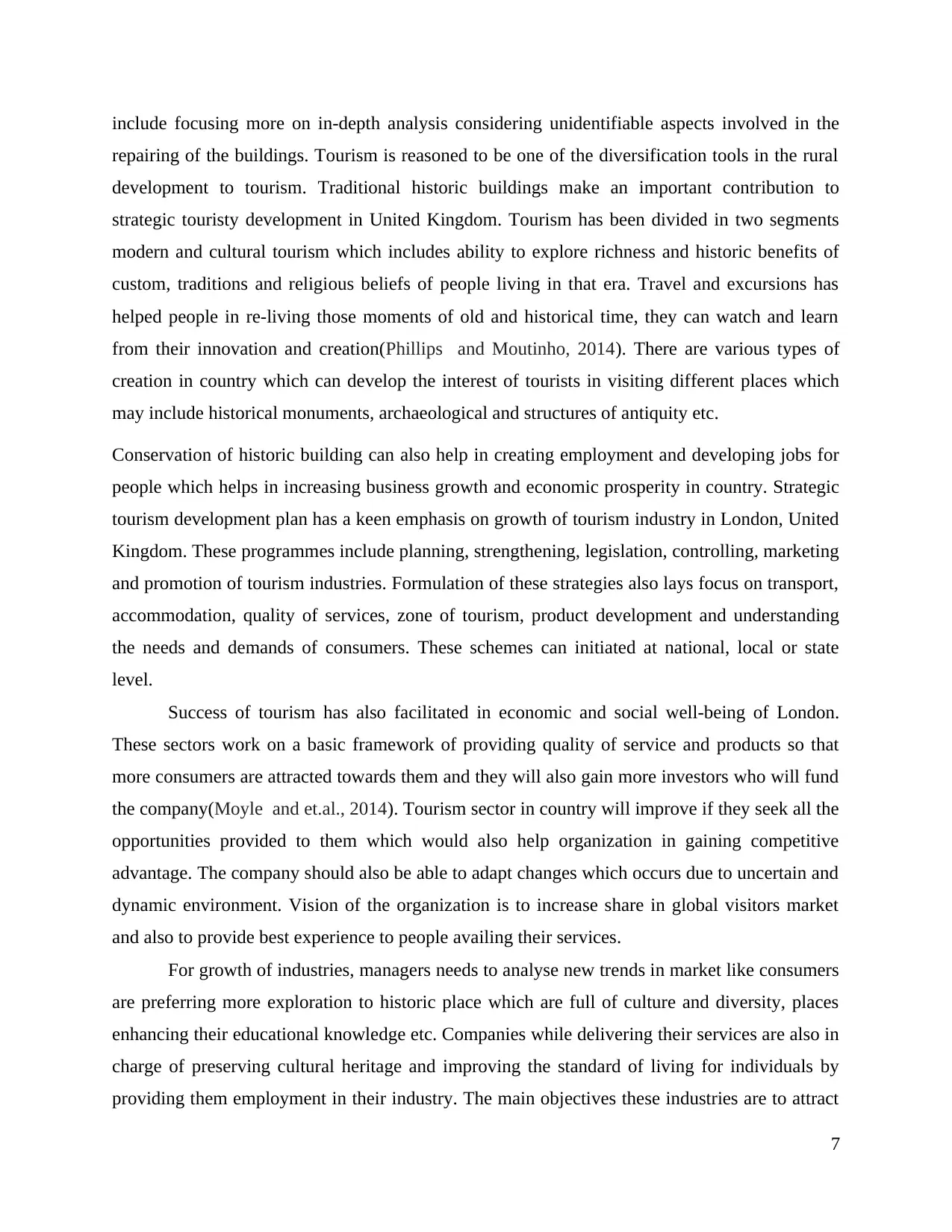
include focusing more on in-depth analysis considering unidentifiable aspects involved in the
repairing of the buildings. Tourism is reasoned to be one of the diversification tools in the rural
development to tourism. Traditional historic buildings make an important contribution to
strategic touristy development in United Kingdom. Tourism has been divided in two segments
modern and cultural tourism which includes ability to explore richness and historic benefits of
custom, traditions and religious beliefs of people living in that era. Travel and excursions has
helped people in re-living those moments of old and historical time, they can watch and learn
from their innovation and creation(Phillips and Moutinho, 2014). There are various types of
creation in country which can develop the interest of tourists in visiting different places which
may include historical monuments, archaeological and structures of antiquity etc.
Conservation of historic building can also help in creating employment and developing jobs for
people which helps in increasing business growth and economic prosperity in country. Strategic
tourism development plan has a keen emphasis on growth of tourism industry in London, United
Kingdom. These programmes include planning, strengthening, legislation, controlling, marketing
and promotion of tourism industries. Formulation of these strategies also lays focus on transport,
accommodation, quality of services, zone of tourism, product development and understanding
the needs and demands of consumers. These schemes can initiated at national, local or state
level.
Success of tourism has also facilitated in economic and social well-being of London.
These sectors work on a basic framework of providing quality of service and products so that
more consumers are attracted towards them and they will also gain more investors who will fund
the company(Moyle and et.al., 2014). Tourism sector in country will improve if they seek all the
opportunities provided to them which would also help organization in gaining competitive
advantage. The company should also be able to adapt changes which occurs due to uncertain and
dynamic environment. Vision of the organization is to increase share in global visitors market
and also to provide best experience to people availing their services.
For growth of industries, managers needs to analyse new trends in market like consumers
are preferring more exploration to historic place which are full of culture and diversity, places
enhancing their educational knowledge etc. Companies while delivering their services are also in
charge of preserving cultural heritage and improving the standard of living for individuals by
providing them employment in their industry. The main objectives these industries are to attract
7
repairing of the buildings. Tourism is reasoned to be one of the diversification tools in the rural
development to tourism. Traditional historic buildings make an important contribution to
strategic touristy development in United Kingdom. Tourism has been divided in two segments
modern and cultural tourism which includes ability to explore richness and historic benefits of
custom, traditions and religious beliefs of people living in that era. Travel and excursions has
helped people in re-living those moments of old and historical time, they can watch and learn
from their innovation and creation(Phillips and Moutinho, 2014). There are various types of
creation in country which can develop the interest of tourists in visiting different places which
may include historical monuments, archaeological and structures of antiquity etc.
Conservation of historic building can also help in creating employment and developing jobs for
people which helps in increasing business growth and economic prosperity in country. Strategic
tourism development plan has a keen emphasis on growth of tourism industry in London, United
Kingdom. These programmes include planning, strengthening, legislation, controlling, marketing
and promotion of tourism industries. Formulation of these strategies also lays focus on transport,
accommodation, quality of services, zone of tourism, product development and understanding
the needs and demands of consumers. These schemes can initiated at national, local or state
level.
Success of tourism has also facilitated in economic and social well-being of London.
These sectors work on a basic framework of providing quality of service and products so that
more consumers are attracted towards them and they will also gain more investors who will fund
the company(Moyle and et.al., 2014). Tourism sector in country will improve if they seek all the
opportunities provided to them which would also help organization in gaining competitive
advantage. The company should also be able to adapt changes which occurs due to uncertain and
dynamic environment. Vision of the organization is to increase share in global visitors market
and also to provide best experience to people availing their services.
For growth of industries, managers needs to analyse new trends in market like consumers
are preferring more exploration to historic place which are full of culture and diversity, places
enhancing their educational knowledge etc. Companies while delivering their services are also in
charge of preserving cultural heritage and improving the standard of living for individuals by
providing them employment in their industry. The main objectives these industries are to attract
7
⊘ This is a preview!⊘
Do you want full access?
Subscribe today to unlock all pages.

Trusted by 1+ million students worldwide
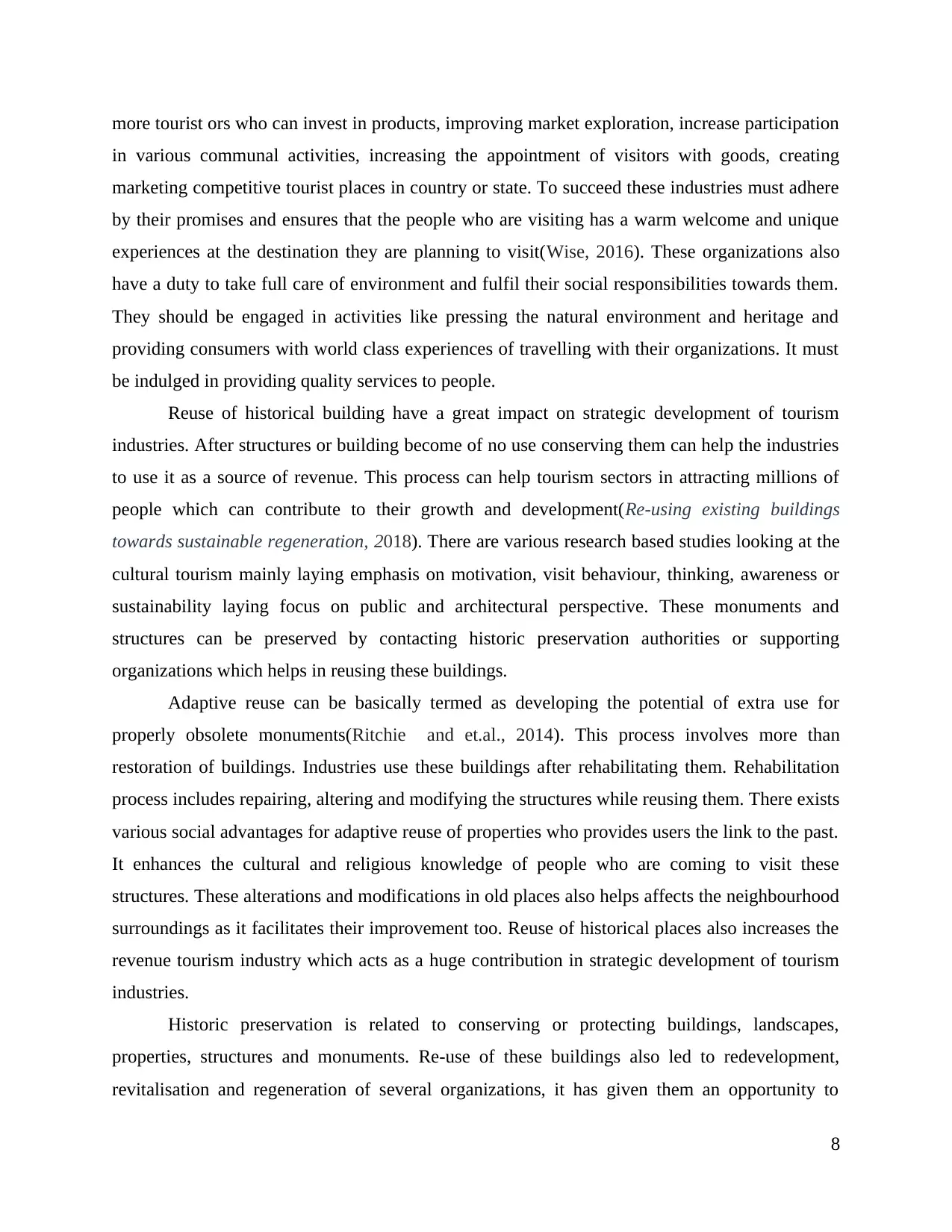
more tourist ors who can invest in products, improving market exploration, increase participation
in various communal activities, increasing the appointment of visitors with goods, creating
marketing competitive tourist places in country or state. To succeed these industries must adhere
by their promises and ensures that the people who are visiting has a warm welcome and unique
experiences at the destination they are planning to visit(Wise, 2016). These organizations also
have a duty to take full care of environment and fulfil their social responsibilities towards them.
They should be engaged in activities like pressing the natural environment and heritage and
providing consumers with world class experiences of travelling with their organizations. It must
be indulged in providing quality services to people.
Reuse of historical building have a great impact on strategic development of tourism
industries. After structures or building become of no use conserving them can help the industries
to use it as a source of revenue. This process can help tourism sectors in attracting millions of
people which can contribute to their growth and development(Re-using existing buildings
towards sustainable regeneration, 2018). There are various research based studies looking at the
cultural tourism mainly laying emphasis on motivation, visit behaviour, thinking, awareness or
sustainability laying focus on public and architectural perspective. These monuments and
structures can be preserved by contacting historic preservation authorities or supporting
organizations which helps in reusing these buildings.
Adaptive reuse can be basically termed as developing the potential of extra use for
properly obsolete monuments(Ritchie and et.al., 2014). This process involves more than
restoration of buildings. Industries use these buildings after rehabilitating them. Rehabilitation
process includes repairing, altering and modifying the structures while reusing them. There exists
various social advantages for adaptive reuse of properties who provides users the link to the past.
It enhances the cultural and religious knowledge of people who are coming to visit these
structures. These alterations and modifications in old places also helps affects the neighbourhood
surroundings as it facilitates their improvement too. Reuse of historical places also increases the
revenue tourism industry which acts as a huge contribution in strategic development of tourism
industries.
Historic preservation is related to conserving or protecting buildings, landscapes,
properties, structures and monuments. Re-use of these buildings also led to redevelopment,
revitalisation and regeneration of several organizations, it has given them an opportunity to
8
in various communal activities, increasing the appointment of visitors with goods, creating
marketing competitive tourist places in country or state. To succeed these industries must adhere
by their promises and ensures that the people who are visiting has a warm welcome and unique
experiences at the destination they are planning to visit(Wise, 2016). These organizations also
have a duty to take full care of environment and fulfil their social responsibilities towards them.
They should be engaged in activities like pressing the natural environment and heritage and
providing consumers with world class experiences of travelling with their organizations. It must
be indulged in providing quality services to people.
Reuse of historical building have a great impact on strategic development of tourism
industries. After structures or building become of no use conserving them can help the industries
to use it as a source of revenue. This process can help tourism sectors in attracting millions of
people which can contribute to their growth and development(Re-using existing buildings
towards sustainable regeneration, 2018). There are various research based studies looking at the
cultural tourism mainly laying emphasis on motivation, visit behaviour, thinking, awareness or
sustainability laying focus on public and architectural perspective. These monuments and
structures can be preserved by contacting historic preservation authorities or supporting
organizations which helps in reusing these buildings.
Adaptive reuse can be basically termed as developing the potential of extra use for
properly obsolete monuments(Ritchie and et.al., 2014). This process involves more than
restoration of buildings. Industries use these buildings after rehabilitating them. Rehabilitation
process includes repairing, altering and modifying the structures while reusing them. There exists
various social advantages for adaptive reuse of properties who provides users the link to the past.
It enhances the cultural and religious knowledge of people who are coming to visit these
structures. These alterations and modifications in old places also helps affects the neighbourhood
surroundings as it facilitates their improvement too. Reuse of historical places also increases the
revenue tourism industry which acts as a huge contribution in strategic development of tourism
industries.
Historic preservation is related to conserving or protecting buildings, landscapes,
properties, structures and monuments. Re-use of these buildings also led to redevelopment,
revitalisation and regeneration of several organizations, it has given them an opportunity to
8
Paraphrase This Document
Need a fresh take? Get an instant paraphrase of this document with our AI Paraphraser
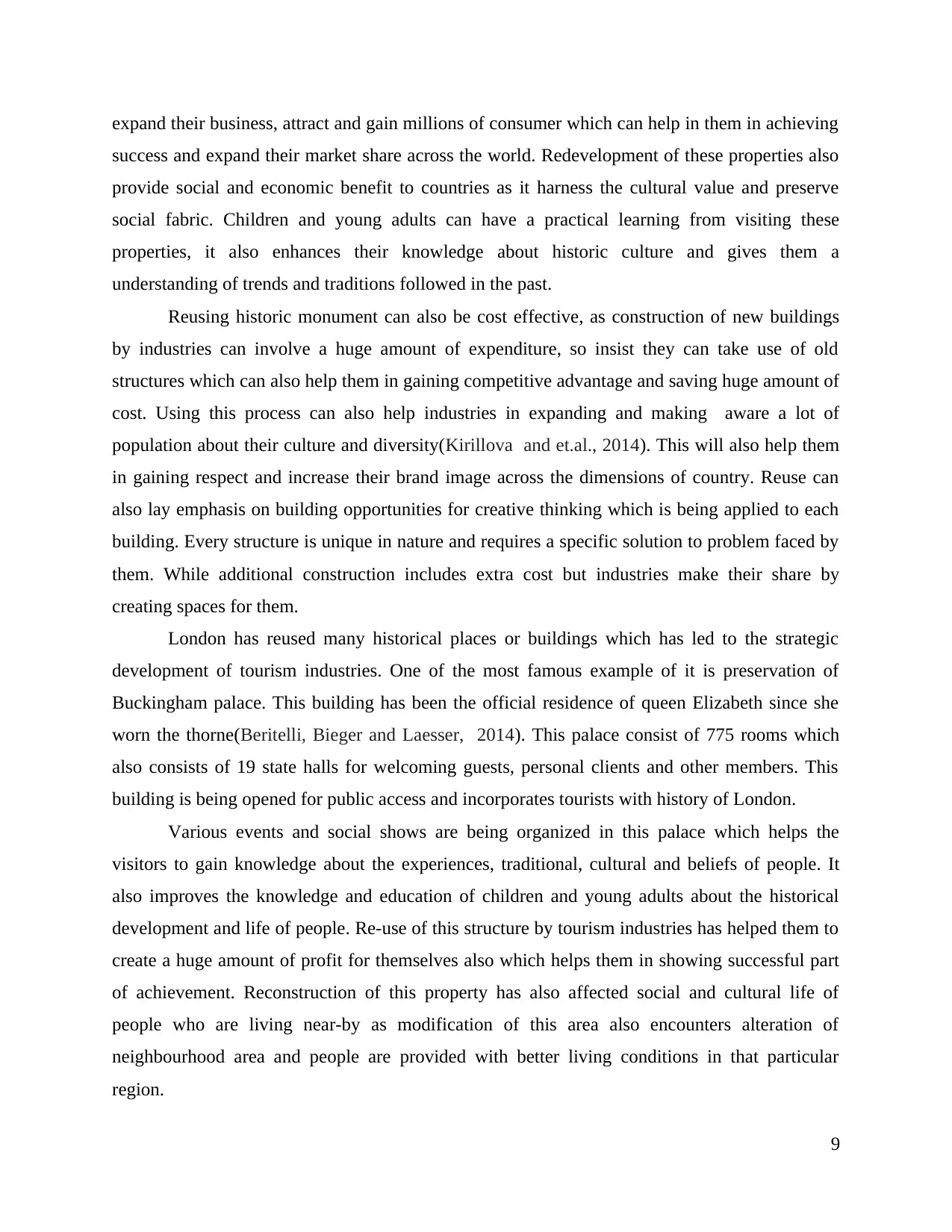
expand their business, attract and gain millions of consumer which can help in them in achieving
success and expand their market share across the world. Redevelopment of these properties also
provide social and economic benefit to countries as it harness the cultural value and preserve
social fabric. Children and young adults can have a practical learning from visiting these
properties, it also enhances their knowledge about historic culture and gives them a
understanding of trends and traditions followed in the past.
Reusing historic monument can also be cost effective, as construction of new buildings
by industries can involve a huge amount of expenditure, so insist they can take use of old
structures which can also help them in gaining competitive advantage and saving huge amount of
cost. Using this process can also help industries in expanding and making aware a lot of
population about their culture and diversity(Kirillova and et.al., 2014). This will also help them
in gaining respect and increase their brand image across the dimensions of country. Reuse can
also lay emphasis on building opportunities for creative thinking which is being applied to each
building. Every structure is unique in nature and requires a specific solution to problem faced by
them. While additional construction includes extra cost but industries make their share by
creating spaces for them.
London has reused many historical places or buildings which has led to the strategic
development of tourism industries. One of the most famous example of it is preservation of
Buckingham palace. This building has been the official residence of queen Elizabeth since she
worn the thorne(Beritelli, Bieger and Laesser, 2014). This palace consist of 775 rooms which
also consists of 19 state halls for welcoming guests, personal clients and other members. This
building is being opened for public access and incorporates tourists with history of London.
Various events and social shows are being organized in this palace which helps the
visitors to gain knowledge about the experiences, traditional, cultural and beliefs of people. It
also improves the knowledge and education of children and young adults about the historical
development and life of people. Re-use of this structure by tourism industries has helped them to
create a huge amount of profit for themselves also which helps them in showing successful part
of achievement. Reconstruction of this property has also affected social and cultural life of
people who are living near-by as modification of this area also encounters alteration of
neighbourhood area and people are provided with better living conditions in that particular
region.
9
success and expand their market share across the world. Redevelopment of these properties also
provide social and economic benefit to countries as it harness the cultural value and preserve
social fabric. Children and young adults can have a practical learning from visiting these
properties, it also enhances their knowledge about historic culture and gives them a
understanding of trends and traditions followed in the past.
Reusing historic monument can also be cost effective, as construction of new buildings
by industries can involve a huge amount of expenditure, so insist they can take use of old
structures which can also help them in gaining competitive advantage and saving huge amount of
cost. Using this process can also help industries in expanding and making aware a lot of
population about their culture and diversity(Kirillova and et.al., 2014). This will also help them
in gaining respect and increase their brand image across the dimensions of country. Reuse can
also lay emphasis on building opportunities for creative thinking which is being applied to each
building. Every structure is unique in nature and requires a specific solution to problem faced by
them. While additional construction includes extra cost but industries make their share by
creating spaces for them.
London has reused many historical places or buildings which has led to the strategic
development of tourism industries. One of the most famous example of it is preservation of
Buckingham palace. This building has been the official residence of queen Elizabeth since she
worn the thorne(Beritelli, Bieger and Laesser, 2014). This palace consist of 775 rooms which
also consists of 19 state halls for welcoming guests, personal clients and other members. This
building is being opened for public access and incorporates tourists with history of London.
Various events and social shows are being organized in this palace which helps the
visitors to gain knowledge about the experiences, traditional, cultural and beliefs of people. It
also improves the knowledge and education of children and young adults about the historical
development and life of people. Re-use of this structure by tourism industries has helped them to
create a huge amount of profit for themselves also which helps them in showing successful part
of achievement. Reconstruction of this property has also affected social and cultural life of
people who are living near-by as modification of this area also encounters alteration of
neighbourhood area and people are provided with better living conditions in that particular
region.
9
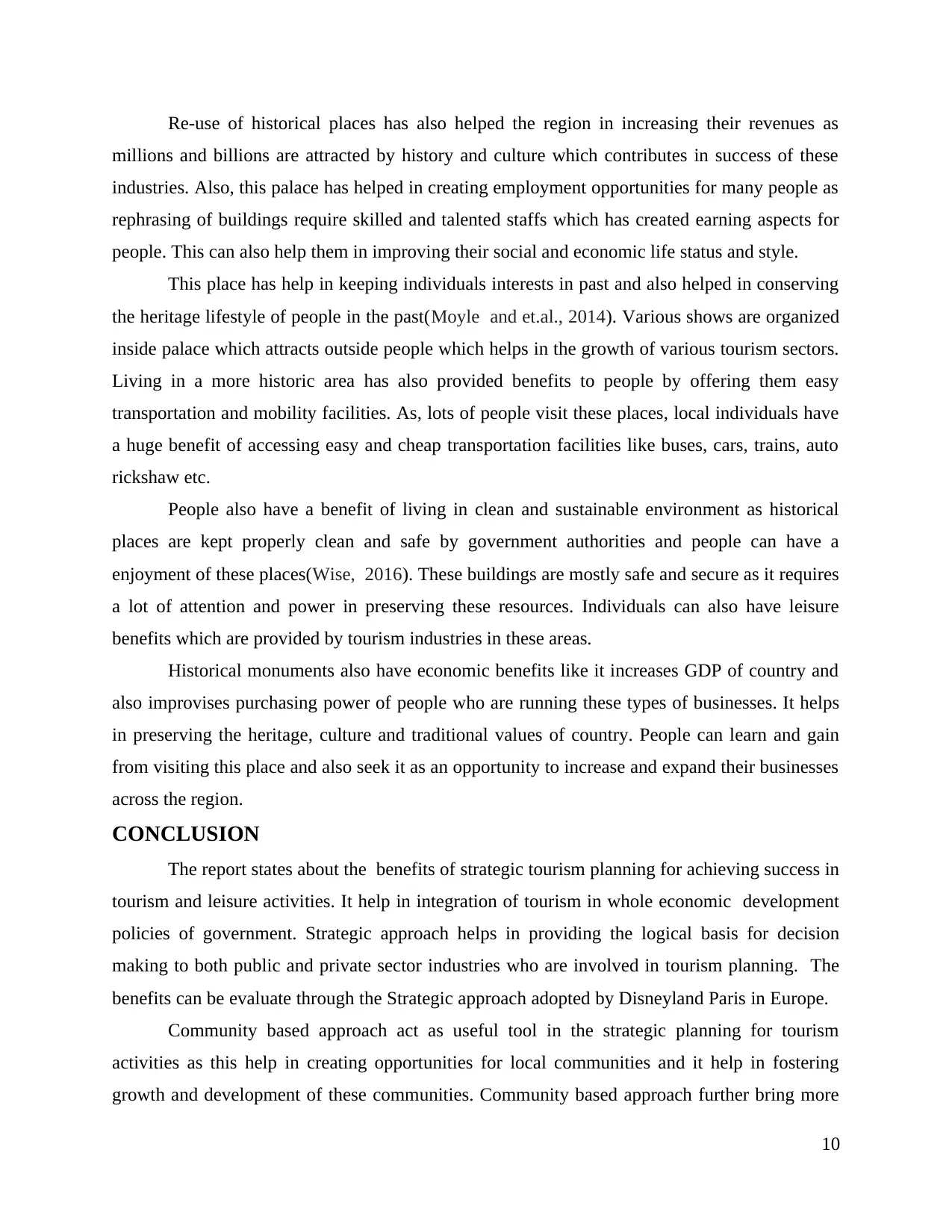
Re-use of historical places has also helped the region in increasing their revenues as
millions and billions are attracted by history and culture which contributes in success of these
industries. Also, this palace has helped in creating employment opportunities for many people as
rephrasing of buildings require skilled and talented staffs which has created earning aspects for
people. This can also help them in improving their social and economic life status and style.
This place has help in keeping individuals interests in past and also helped in conserving
the heritage lifestyle of people in the past(Moyle and et.al., 2014). Various shows are organized
inside palace which attracts outside people which helps in the growth of various tourism sectors.
Living in a more historic area has also provided benefits to people by offering them easy
transportation and mobility facilities. As, lots of people visit these places, local individuals have
a huge benefit of accessing easy and cheap transportation facilities like buses, cars, trains, auto
rickshaw etc.
People also have a benefit of living in clean and sustainable environment as historical
places are kept properly clean and safe by government authorities and people can have a
enjoyment of these places(Wise, 2016). These buildings are mostly safe and secure as it requires
a lot of attention and power in preserving these resources. Individuals can also have leisure
benefits which are provided by tourism industries in these areas.
Historical monuments also have economic benefits like it increases GDP of country and
also improvises purchasing power of people who are running these types of businesses. It helps
in preserving the heritage, culture and traditional values of country. People can learn and gain
from visiting this place and also seek it as an opportunity to increase and expand their businesses
across the region.
CONCLUSION
The report states about the benefits of strategic tourism planning for achieving success in
tourism and leisure activities. It help in integration of tourism in whole economic development
policies of government. Strategic approach helps in providing the logical basis for decision
making to both public and private sector industries who are involved in tourism planning. The
benefits can be evaluate through the Strategic approach adopted by Disneyland Paris in Europe.
Community based approach act as useful tool in the strategic planning for tourism
activities as this help in creating opportunities for local communities and it help in fostering
growth and development of these communities. Community based approach further bring more
10
millions and billions are attracted by history and culture which contributes in success of these
industries. Also, this palace has helped in creating employment opportunities for many people as
rephrasing of buildings require skilled and talented staffs which has created earning aspects for
people. This can also help them in improving their social and economic life status and style.
This place has help in keeping individuals interests in past and also helped in conserving
the heritage lifestyle of people in the past(Moyle and et.al., 2014). Various shows are organized
inside palace which attracts outside people which helps in the growth of various tourism sectors.
Living in a more historic area has also provided benefits to people by offering them easy
transportation and mobility facilities. As, lots of people visit these places, local individuals have
a huge benefit of accessing easy and cheap transportation facilities like buses, cars, trains, auto
rickshaw etc.
People also have a benefit of living in clean and sustainable environment as historical
places are kept properly clean and safe by government authorities and people can have a
enjoyment of these places(Wise, 2016). These buildings are mostly safe and secure as it requires
a lot of attention and power in preserving these resources. Individuals can also have leisure
benefits which are provided by tourism industries in these areas.
Historical monuments also have economic benefits like it increases GDP of country and
also improvises purchasing power of people who are running these types of businesses. It helps
in preserving the heritage, culture and traditional values of country. People can learn and gain
from visiting this place and also seek it as an opportunity to increase and expand their businesses
across the region.
CONCLUSION
The report states about the benefits of strategic tourism planning for achieving success in
tourism and leisure activities. It help in integration of tourism in whole economic development
policies of government. Strategic approach helps in providing the logical basis for decision
making to both public and private sector industries who are involved in tourism planning. The
benefits can be evaluate through the Strategic approach adopted by Disneyland Paris in Europe.
Community based approach act as useful tool in the strategic planning for tourism
activities as this help in creating opportunities for local communities and it help in fostering
growth and development of these communities. Community based approach further bring more
10
⊘ This is a preview!⊘
Do you want full access?
Subscribe today to unlock all pages.

Trusted by 1+ million students worldwide
1 out of 15
Related Documents
Your All-in-One AI-Powered Toolkit for Academic Success.
+13062052269
info@desklib.com
Available 24*7 on WhatsApp / Email
![[object Object]](/_next/static/media/star-bottom.7253800d.svg)
Unlock your academic potential
Copyright © 2020–2025 A2Z Services. All Rights Reserved. Developed and managed by ZUCOL.




